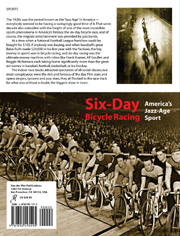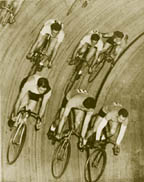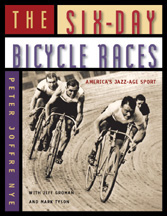


|
|
|
|
|
|
|
|
|
|
|
|
|
|
|
|
|
|
|
|
|
|
|
|
The Six-Day Bicycle RacesAmerica's Jazz-Age SportPeter Joffre Nye, with Jeff Groman and Mark Tyson |
|||||||||||||||||||||||
|
Press Review: Bicycling MagazineJanuary 2009
On the dedication page of
The Six-Day Bicycles Races,
America's Jazz-Age Sport,
the authors of this homage to
velodrome bicycle racing in
the United States thank their
families for "giving them the
blue-sky to rescue the history
of this once robust sport."
The 225 pages that follow are hardly a rescue mission; more a labor of love by three men who invested their time, care and enduring passion to bring a period when cycling was king to life. Peter Joffre Nye takes the lead on Six-Day Bicycle Races, backed by the contributions of cycling historians Jeff Groman and Mark Tyson. The result is a meticulously researched and elaborate coffee table book featuring stories, photographs, news clippings and memorabilia from an era when bike racing captivated our collective conscious and cyclists were the major league sports heroes of the time. Six-Day Bicycle Races begins with high wheel bicycles in the 1870's and ends with Americans Marty Nothstein and Ryan Oelkers claiming victory at the Moscow Six-Day in 2002. It was the first US Madison team claimed victory since Charlie Bergna and Cecil Yates won Cleveland in 1949; and one that was built on the blood, sweat and guts of the legends found on the pages in between. Six-day racing is one of the most grueling, physically demanding sports of all time. This book captures its birth and will be cherished by anyone who loves riding or racing bikes, sports history, or has ever been mesmerized by the fast-paced, adrenaline rush of velodrome track racing. Liz Reap Carlson
|
||||||||||||||||||||||
| From the contents |

|

|
 Author and Contributor BackgroundOn a steaming July morning in metropolitan New York City during the early 1960s, I waited on the start line with other junior boys, ages sixteen and under, when officials I then considered ancient men suddenly became animated. The sun burned through a cloudless sky, driving the temperature up and our IQs down. Yet the old- timers—course marshals, road guards, and others—became energized, even youthful again. They shouted, “It’s Reggie! Reggie McNamara! Greatest Six-Day rider ever!” Incredibly, on the melting asphalt they transformed from shuffling geezers to gazelles bounding in McNamara’s direction. I never saw McNamara, who had retired before any of us juniors had been born, and he had left by the time my race finished, yet I recalled the commotion he caused. When Jeff Groman grew up in the 1950–60s in Boonton, New Jersey, he played in the basement of childhood neighbor Ray Dawson III, whose grandfather had raced in the 1890s. In the basement of the Dawson house were a ticket booth, vintage high-wheelers, and other memorabilia. “We’d spin the wheels in our hands, look at the photos, wonder what those old days were like,” Jeff recounts. As a teenager, he hung around a local bike shop run by Italians, the Marcello Brothers. “Naturally, I grew up thinking I was Italian,” he says. “When I was fourteen, my parents told me I was Jewish.” Among the shop smells of grease and new tires on Schwinn bicycles, he heard about Six-Day races around steeply banked indoor board tracks in New York City’s Madison Square Garden, Chicago, and others cities. He learned of the outdoor racing season on ovals in Newark and Nutley. He discovered riders named McNamara, Alf Goullet, Norman Hill, and Sammy Gastman. “One day an old guy in the shop insisted I go with him to his house. He showed me a leather glove. Held it like it was sacred. Said it had belonged to Alfred LeTourner. After a Six-Day, LeTourner had thrown his gloves into the audience. This guy caught one, like a bride’s bouquet. I had no idea what the glove meant to him or who LeTourner was.” After graduating from the University of New Hampshire, Jeff pedaled around Europe and wound up back in New Jersey, wrenching in a bike shop. During slack time, he leafed through old trade journals and read columns by Walter Bardgett, who wrote about LeTourner, McNamara, and their comrades. “I realized that these old Six-Day guys were real. I heard some of them talk when they came into the Marcello Brothers’ shop.” Inspired, Jeff bought an early-generation Sony High-8 digital sound recorder, and made home videos of Goullet, Hill, and other surviving veterans. “I wanted to do an oral history, because these guys were wonderful. They told great stories.” Meanwhile, film producer Mark Tyson in Colorado Springs considered doing a documentary on cycling. He discussed it with Andy Taos, an international cycling commissar, who suggested that he interview the dwindling band of Six-Day veterans. That led him to Richard Schwinn, a fourth-generation frame builder in Waterford, Wisconsin. Richard put him in touch with Jeff, who had relocated to suburban Seattle and was a collector of bicycling memorabilia and now the owner of two bike shops. Mark admits that he had a passing knowledge of the Sixes, but no depth. “I knew that the Sixes had a hay day and then disappeared. I didn’t get a feel or a true sense until I went to Seattle and did some interviews with Jeff and looked at his photos. Then everybody I talked with has brought a new angle. The experience was like falling down the rabbit hole in Alice in Wonderland.” Jeff, Mark, and I researched the era of Six-Days. “My single overwhelming impression has been that it was such a huge piece of popular culture of the day that it’s hard to conceive how this could have been lost,” Mark observes. “Six-Days amounted to a major chunk of the entertainment in New York City, Chicago, and about 15 other cities. When you have athletes who were the biggest names in their day, considered on a par with Babe Ruth in 1925, you have to ask—how could those athletes disappear from the sporting history of the country?” For more than a half-century, Six-Days thrived as an American sports tradition. Six-Day riders were treated as heroes. Every season they set a new round of world records—most of which outlived the men who set them. Today their legacy remains the multi-day road races such as the Tour de France, originally modeled from the Six-Day format. Our celebrated road racers today are pulled through history’s slipstream by riders flashing around indoor board tracks of the Sixes. Peter Joffre Nye |
